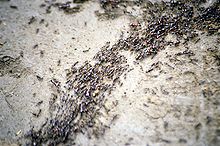This article has multiple issues. Please help improve it or discuss these issues on the talk page. (Learn how and when to remove these messages)
|


In computer science and operations research, the ant colony optimization algorithm (ACO) is a probabilistic technique for solving computational problems that can be reduced to finding good paths through graphs. Artificial ants represent multi-agent methods inspired by the behavior of real ants. The pheromone-based communication of biological ants is often the predominant paradigm used.[2] Combinations of artificial ants and local search algorithms have become a preferred method for numerous optimization tasks involving some sort of graph, e.g., vehicle routing and internet routing.
As an example, ant colony optimization[3] is a class of optimization algorithms modeled on the actions of an ant colony.[4] Artificial 'ants' (e.g. simulation agents) locate optimal solutions by moving through a parameter space representing all possible solutions. Real ants lay down pheromones to direct each other to resources while exploring their environment. The simulated 'ants' similarly record their positions and the quality of their solutions, so that in later simulation iterations more ants locate better solutions.[5] One variation on this approach is the bees algorithm, which is more analogous to the foraging patterns of the honey bee, another social insect.
This algorithm is a member of the ant colony algorithms family, in swarm intelligence methods, and it constitutes some metaheuristic optimizations. Initially proposed by Marco Dorigo in 1992 in his PhD thesis,[6][7] the first algorithm was aiming to search for an optimal path in a graph, based on the behavior of ants seeking a path between their colony and a source of food. The original idea has since diversified to solve a wider class of numerical problems, and as a result, several problems have emerged, drawing on various aspects of the behavior of ants. From a broader perspective, ACO performs a model-based search[8] and shares some similarities with estimation of distribution algorithms.
- ^ Waldner, Jean-Baptiste (2008). Nanocomputers and Swarm Intelligence. London: ISTE John Wiley & Sons. p. 225. ISBN 978-1-84704-002-2.
- ^ Monmarché Nicolas; Guinand Frédéric; Siarry Patrick (2010). Artificial Ants. Wiley-ISTE. ISBN 978-1-84821-194-0.
- ^ M. Dorigo; L. M. Gambardella (1997). "Learning Approach to the Traveling Salesman Problem". IEEE Transactions on Evolutionary Computation. 1 (1): 214. doi:10.1109/4235.585892.
- ^ Birattari, M.; Pellegrini, P.; Dorigo, M. (2007). "On the Invariance of Ant Colony Optimization". IEEE Transactions on Evolutionary Computation. 11 (6). Institute of Electrical and Electronics Engineers (IEEE): 732–742. doi:10.1109/tevc.2007.892762. ISSN 1941-0026. S2CID 1591891.
- ^ Ant Colony Optimization by Marco Dorigo and Thomas Stützle, MIT Press, 2004. ISBN 0-262-04219-3
- ^ A. Colorni, M. Dorigo et V. Maniezzo, Distributed Optimization by Ant Colonies, actes de la première conférence européenne sur la vie artificielle, Paris, France, Elsevier Publishing, 134-142, 1991.
- ^ M. Dorigo, Optimization, Learning and Natural Algorithms, PhD thesis, Politecnico di Milano, Italy, 1992.
- ^ M. Zlochin, M. Birattari, N. Meuleau, et M. Dorigo, Model-based search for combinatorial optimization: A critical survey, Annals of Operations Research, vol. 131, pp. 373-395, 2004.